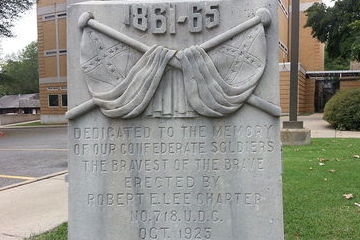
02/09/2018
In mid-August 2017, a group of white nationalists gathered to protest the planned removal of a statue of Robert E. Lee from Emancipation Park in Charlottesville, Va. There, a white supremacist murdered Heather Heyer and 19 others were injured when he drove his car into a group of counter protestors.
The ensuing national debate over Confederate monuments became a political flashpoint, dividing people among racial and geographical lines.
That discussion will continue at SUNY Cortland with a panel discussion and question-and-answer session, “Confederate Monuments: Should They Stay or Should They Go?” The event takes place from 5 to 6:30 p.m. Thursday, Feb. 15, in Brockway Hall Jacobus Lounge. It is free and open to the public.
“Some of that history gets lost in the debate when it gets so simplified,” said Evan Faulkenbury, assistant professor of history. “Do we leave them up or do we tear them down? We need to understand the history about them and the context about them. Then we can have an informed discussion about what they mean and whether they’re important to us or not important to us.”
Faulkenbury, who specializes in public history, the civil rights movement and the American South, will be one of three panelists. He will be joined by Christopher Ortega, assistant professor of communication studies and SUNY Geneseo History Department chair Justin Behrend. Randi Storch, chair of SUNY Cortland’s History Department, will serve as moderator.
The purpose of monuments to the Confederacy is at the crux of the debate. While some argue that removal of the statues is an attempt to erase history, Faulkenbury urges people to consider the context in which the monuments were installed.
“For the most part, they were not put up immediately after the Civil War,” Faulkenbury said. “They were put up decades later with a different purpose in mind. It was the Jim Crow era and the era of segregation. These Confederate monuments were less about the specific Confederate dead and more about trying to remind black people that they were secondary citizens. They were drawing on the myth of the lost cause.”
While SUNY Cortland does not have any such markers on its campus, universities and municipalities across the country have investigated ways to respond to Confederate tributes in public spaces. Faulkenbury stressed that there are many options other than straight removal. Some monuments have been moved into museums. Other statues have been left standing with signage added to highlight the history behind those who erected it in the first place.
In class, Faulkenbury said he has heard a wide range of opinions on the topic from his students. He hopes to expand the discussion even further during the event.
“Audience members should feel free to give their own two cents and speak their mind,” Faulkenbury said. “We don’t want it to be a forum where the three scholars give our opinions and walk out. We really want it to be a conversation and a place where people can ask questions and respectfully disagree. We want people to come with their ideas and be open to new ideas as well."
The discussion is part of the Africana Studies Department’s series of Black History Month events and is supported by the Cultural and Intellectual Climate Committee, the President’s Office and the Campus Artist and Lecture Series.
For more information, contact Faulkenbury at 607-753-2035.